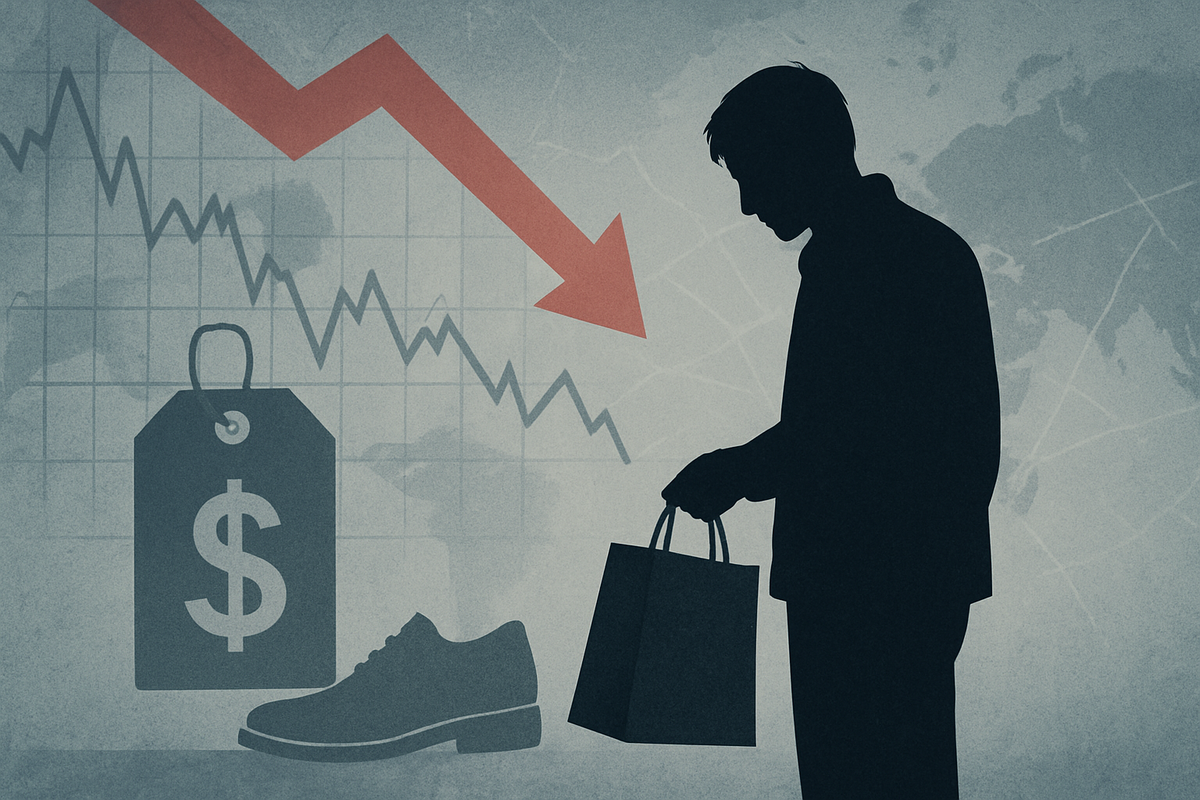
New York, NY – October 24, 2025 – Deckers Outdoor Corporation (NYSE: DECK), the powerhouse behind popular brands like Hoka and UGG, saw its shares plummet by nearly 14% today following a weaker-than-expected full-year outlook and stark warnings of a potential consumer pullback. The significant drop, occurring despite strong fiscal second-quarter results, underscores growing investor anxiety over macroeconomic headwinds, particularly the anticipated full impact of tariffs and persistent higher prices on American consumers.
The immediate implications are clear: a major player in the athletic and casual footwear market is signaling tougher times ahead. This unexpected guidance has sent ripples through the retail sector, raising concerns that the broader consumer discretionary spending environment could be far more challenging than previously anticipated.
Detailed Coverage: A Cautious Step Forward
Deckers Outdoor's stock plunge on October 24, 2025, was a direct response to the company's revised financial projections. Despite reporting robust fiscal second-quarter results that surpassed analyst expectations—with earnings per share reaching $1.82 and revenue climbing 9.1% year-over-year to $1.43 billion—the future guidance painted a less optimistic picture. The company issued a full-year sales forecast of approximately $5.35 billion and provided an earnings per share guidance for the fiscal year ending March 2026 that fell below consensus estimates.
The primary driver behind this cautious outlook, as articulated by CEO Stefano Caroti during the earnings call, was the expectation of a "more cautious consumer as the full impact of tariffs and price increases will be felt here in the U.S." CFO Steven Fasching further elaborated, noting that U.S. consumers were already showing signs of pulling back on discretionary purchases due to these inflationary pressures. Deckers anticipates an increase of up to $150 million in its cost of goods sold for fiscal 2026 directly from tariffs, which is expected to pressure gross margins, even with plans for selective price increases and cost-sharing negotiations with manufacturing partners. The company's domestic net sales also saw a slight decline of 1.7% in the quarter, a stark contrast to the 14.2% rise a year prior.
This immediate market reaction, which saw Deckers' shares contribute to a nearly 50% year-to-date decline, highlights how investor sentiment can swiftly shift from celebrating past performance to scrutinizing future uncertainties. The company's strong brand momentum, particularly with its Hoka performance running shoes and UGG comfort footwear, was overshadowed by the broader economic concerns.
Industry Impact: Shifting Sands for Footwear Brands
Deckers Outdoor's warning is not an isolated event; it casts a long shadow over the entire athletic and casual footwear industry, creating potential winners and losers in a newly price-sensitive market.
Potential Winners: Companies offering perceived value and comfort at more accessible price points are likely to fare better. Crocs (NASDAQ: CROX), known for its affordable and comfortable casual footwear, is well-positioned to capture market share from consumers trading down. Its acquisition of HeyDude further strengthens its casual sneaker presence. Similarly, Skechers (NYSE: SKX), with its wide range of comfortable and value-oriented athletic and casual shoes, has historically thrived during periods of economic uncertainty, attracting consumers away from premium brands due to its "high comfort and affordable pricing." Both Crocs and Skechers could see increased demand as consumers prioritize budget-friendly options.
Potential Losers: Premium-priced brands and those heavily reliant on specific manufacturing regions could face significant headwinds. While giants like Nike (NYSE: NKE) and Adidas (XTRA: ADS) command dominant market shares, they are not immune to a broad consumer pullback. Nike, despite its size, has already faced challenges, including a reported drop in global market share for sneakers and apparel, and an overhang of unsold inventory for some of its popular models. Adidas has also experienced flat performance in volatile markets. If consumers reduce discretionary spending on higher-priced athletic footwear, these companies may need to increase promotional activities, further impacting margins. Deckers itself anticipates margin pressure and the need for promotions to entice shoppers, indicating that even strong brands will feel the pinch.
Wider Significance: A Broader Economic Barometer
Deckers Outdoor's cautious outlook serves as a potent barometer for broader economic trends, extending far beyond the footwear aisle. The warning about tariffs and higher prices triggering a consumer pullback resonates with existing data indicating a significant shift in consumer behavior. Surveys suggest that a substantial portion of consumers are deprioritizing footwear purchases due to inflation, becoming increasingly price-sensitive, and willing to switch brands or retailers for better deals. The average consumer is expected to reduce their footwear budget by approximately $35 in the coming year.
The ripple effects are profound. Supply Chains are being fundamentally reshaped by U.S. tariffs, some reaching as high as 145% on footwear imports. Tariffs on goods from Vietnam (46% increase), Indonesia (32%), and China (54%) directly impact major brands that rely heavily on these manufacturing hubs. This escalates production costs, disrupts logistics, and forces companies to diversify sourcing, often at a higher cost. The unpredictable nature of trade policies creates immense uncertainty for long-term planning. For Retail Partners, these increased costs are passed to consumers, leading to reduced demand and increased promotional activities. Retail data from January 2025 already showed an almost 8% drop in shoe store sales year-over-year, highlighting the existing strain.
On a Broader Economic scale, the National Retail Federation estimates that U.S. consumers could lose between $46 billion and $78 billion in spending power annually due to tariffs, with $6.4 billion to $10.7 billion directly impacting footwear purchases. This could lead to a significant reduction in overall consumer purchases. The U.S. footwear industry already faces some of the highest tariffs among consumer goods, averaging 12.3%. Industry organizations, like the Footwear Distributors and Retailers of America (FDRA), have vehemently opposed these measures, citing potential store closures, job losses, and increased financial strain on American families. Historically, such tariff regimes, like the 1890 McKinley Tariff and the 1930s Smoot-Hawley Tariff, have led to widespread price surges, retaliatory trade measures, and broader economic recessions, serving as a stark warning for the current situation.
What Comes Next: Navigating the Headwinds
The coming months will be critical for Deckers Outdoor and the broader footwear industry as they navigate these challenging economic currents.
In the short-term, Deckers will likely focus on managing its anticipated margin pressure through selective price increases and operational efficiencies. The company's reliance on manufacturing in Vietnam makes it particularly vulnerable to tariff impacts, necessitating a continued push for supply chain diversification. Maintaining the strong momentum of its Hoka and UGG brands through targeted marketing and product innovation will be crucial to sustain growth amidst a cautious consumer. For the broader industry, expect heightened promotional activity, increased price competition, and continued pressure on sales volumes as consumers prioritize essential spending.
Looking long-term, strategic pivots will be essential. Deckers is already focused on international expansion, particularly in Asia and Europe, and investing in its direct-to-consumer (DTC) channels to improve margins and customer engagement. Supply chain diversification, moving away from heavily tariffed regions, will be a persistent theme across the industry. Brands will need to double down on product innovation, focusing on comfort, functionality, and increasingly, sustainability, as these factors continue to drive consumer preference. Companies leveraging technology—from AI for demand forecasting to AR for virtual try-ons—could gain a significant competitive edge. The shift towards casual and athletic footwear is expected to continue, but with a stronger emphasis on value.
Potential scenarios range from resilient growth for agile brands that successfully adapt to a more significant margin erosion for those unable to mitigate costs or respond to changing consumer demands. Companies with strong brand equity and diversified operations, like Deckers, may weather the storm, albeit with slower growth. However, less diversified or premium-only players could face more substantial challenges, potentially leading to market consolidation or strategic restructuring.
Comprehensive Wrap-Up: A Test of Resilience
Deckers Outdoor's stock plunge today serves as a stark reminder of the fragile state of consumer confidence and the significant impact of global trade policies on corporate performance. The key takeaways are clear: the footwear industry is bracing for a period of heightened consumer price sensitivity, driven by tariffs and persistent inflation. This environment will test the resilience of even the strongest brands, forcing strategic adaptations in supply chain management, pricing, and product offerings.
Moving forward, investors should closely watch for continued signs of consumer pullback in retail sales data, further announcements regarding tariff impacts from other major apparel and footwear companies, and how brands like Deckers (NYSE: DECK) implement their strategic pivots. The ability to diversify supply chains, innovate effectively while offering compelling value, and engage directly with consumers will be paramount for navigating this challenging landscape. The coming months will undoubtedly reveal which companies possess the agility and foresight to thrive in a market defined by economic uncertainty.
This content is intended for informational purposes only and is not financial advice


















